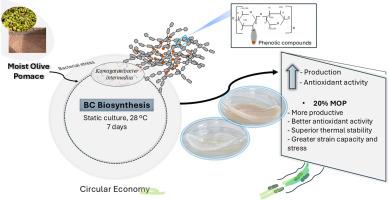细菌纤维素生物合成在生湿橄榄渣的存在:绿色可持续的方法,提高生物聚合物的生产和性能
IF 5.8
2区 生物学
Q1 AGRICULTURAL ENGINEERING
引用次数: 0
摘要
本研究研究了从康普茶中分离的Komagataeibacter intermedius菌株在发酵培养基中浓度高达40%的生湿橄榄渣(MOP)存在下对细菌纤维素(BC)的生物合成。对BC膜的抗氧化活性、结构特性、结晶度、热稳定性和力学性能进行了表征。使用生MOP激活了酚类化合物的固有活性,导致细胞在不利条件下适应,并增加了所有测试MOP浓度下的BC产量(p <;0.0001)。这导致20% MOP组与对照(HS培养基)相比增加了166.61%。对于该样品,发现抗氧化活性增强(比对照高约40倍),这可能与BC羟基和酚类化合物之间建立的分子相互作用有关。此外,与对照组相比,应变能力提高了603.03%,断裂应力提高了376.01%。该研究证实,BC可以在自然状态下使用MOP合成,支持可持续循环经济,同时增强增值产品的生物合成。通过减少合成介质和利用MOP,可以实现更绿色的生物工艺,扩大BC的适用性。本文章由计算机程序翻译,如有差异,请以英文原文为准。

Bacterial cellulose biosynthesis in the presence of raw moist olive pomace: A green sustainable approach that enhances biopolymer production and properties
In this study, the biosynthesis of bacterial cellulose (BC) by Komagataeibacter intermedius strain isolated from Kombucha tea in the presence of raw moist olive pomace (MOP) (concentration up to 40 % in the fermentation media) was studied. The BC membranes were characterized by their antioxidant activity, structural characteristics, crystallinity, thermal stability, and mechanical behavior. Using raw MOP activated the inherent activity of the phenolic compounds, leading to cellular adaptation under unfavorable conditions and increased BC production for all tested MOP concentrations (p < 0.0001). This led to a 166.61 % increase for the 20 % MOP group compared to the control (HS medium). For this sample, enhanced antioxidant activity (∼40-fold higher than the control) was found, which might be associated with the molecular interactions established between hydroxyls of BC and phenolic compounds. Moreover, an increase of 603.03 % in strain capacity, and a 376.01 % improvement in stress at break compared to the control was observed. The study confirmed that BC can be synthesized using MOP in its natural state, supporting a sustainable circular economy while enhancing the biosynthesis of a value-added product. By reducing synthetic media and utilizing MOP, a greener bioprocess can be achieved, and BC's applicability can be expanded.
求助全文
通过发布文献求助,成功后即可免费获取论文全文。
去求助
来源期刊

Biomass & Bioenergy
工程技术-能源与燃料
CiteScore
11.50
自引率
3.30%
发文量
258
审稿时长
60 days
期刊介绍:
Biomass & Bioenergy is an international journal publishing original research papers and short communications, review articles and case studies on biological resources, chemical and biological processes, and biomass products for new renewable sources of energy and materials.
The scope of the journal extends to the environmental, management and economic aspects of biomass and bioenergy.
Key areas covered by the journal:
• Biomass: sources, energy crop production processes, genetic improvements, composition. Please note that research on these biomass subjects must be linked directly to bioenergy generation.
• Biological Residues: residues/rests from agricultural production, forestry and plantations (palm, sugar etc), processing industries, and municipal sources (MSW). Papers on the use of biomass residues through innovative processes/technological novelty and/or consideration of feedstock/system sustainability (or unsustainability) are welcomed. However waste treatment processes and pollution control or mitigation which are only tangentially related to bioenergy are not in the scope of the journal, as they are more suited to publications in the environmental arena. Papers that describe conventional waste streams (ie well described in existing literature) that do not empirically address ''new'' added value from the process are not suitable for submission to the journal.
• Bioenergy Processes: fermentations, thermochemical conversions, liquid and gaseous fuels, and petrochemical substitutes
• Bioenergy Utilization: direct combustion, gasification, electricity production, chemical processes, and by-product remediation
• Biomass and the Environment: carbon cycle, the net energy efficiency of bioenergy systems, assessment of sustainability, and biodiversity issues.
 求助内容:
求助内容: 应助结果提醒方式:
应助结果提醒方式:


